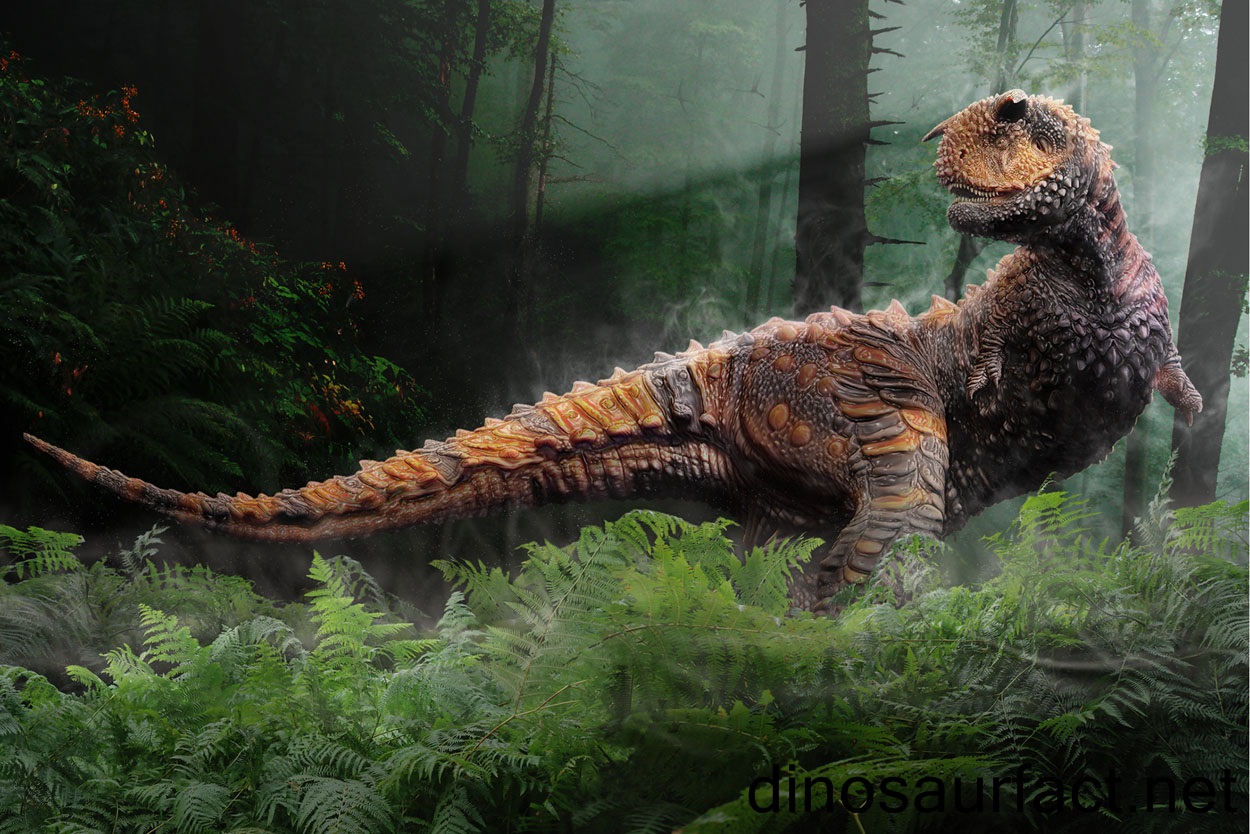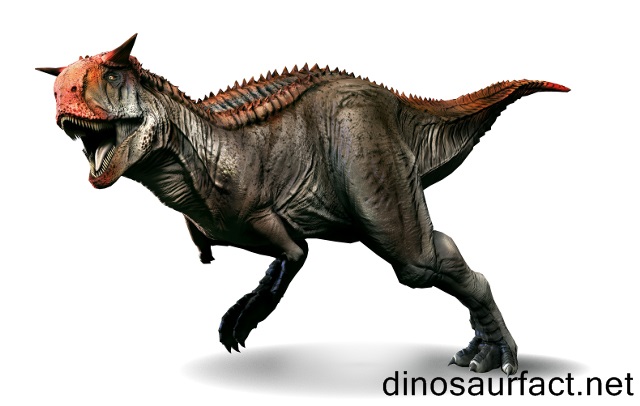 Click to visit the previous dinosaur bio
Click to visit the previous dinosaur bio
 |
|
 |
|
Kingdom: Animalia
Phylum: Chordata
SuperOrder: Dinosauria
Order: Theropoda
Family: Abelisauridae
Genus: Carnotaurus
 |
|
 |
|
 |
|

The Carnotaurus was Cretaceous theropod dinosaur. This means that it was a meat eating reptile. It belonged to the family Abelisauridae, which contained theropods with highly modified forelimbs. Like other abelisaurids, it had extremely short arms. They were reduced to such an extent that they could not called anything but vestigial. This would necessitate a bipedal posture. Yet, the most distinctive features of the Carnotaurus were the bony prominences on its frontal bone. No other abelisaurid has such appendages.
The time period during which the Carnotaurus was present on the earth was about 75 to 65 million years ago. This lies from the Campanian and Maastrichtian border to well within the Maastrichtian age of the late Cretaceous period. It is even possible that this animal as thriving till the Cretaceous Paleogene extinction event.
The Carnotaurus was a lean and lithe dinosaur. Its length was about 9 meters and its weight was only about 1200 to 1400 kilos. Such specific details are known about this reptile because a very well preserved skeleton complete with the outline of the skin is attributed to it. It is in fact on the best described large theropod dinosaur.
The remains of this dinosaur were found in Chubut Province of Argentina.
Etymology
The name Carnotaurus is a combination of two words. The prefix ‘carno’ is derived from the Latin word ‘carnis’ which means ‘flesh’. The word ‘taurus’ is the Latin term for ‘bull’. The horns on the frontal bone of this reptile give it an appearance like a bull. And since it is carnivorous, its name roughly translates to ‘flesh eating bull’.
The specific name C. sastrei is derived from the name of the landowner on whose property the bones of the Carnotaurus were discovered. The farm was called ‘Pocho Sastre’, and Angle Sastre was its proprietor. The suffix ‘i’ is generally added to denote that the scientific name is obtained from a proper noun.
The christening of the remains of the Carnotaurus was performed by Argentinian scientist Jose Bonaparte.
Discovery and nature of fossils
- The remains of the Carnotaurus were discovered in the La Colonia Formation of the Chubut Province of Argentina in the 1984.
- The project within which this expedition was conducted had begun in the year 1976. This excursion happened to be the eight of the project and was led by Jose Bonaparte.
- The fossils were found in a hard iron containing rock and hence harvesting them was a tedious and arduous procedure.
- The individual dinosaur that was found in the Pocho Sastre ranch was lying down on its right side, with the neck being rested on the chest.
- Almost the whole of the skeleton was preserved here, with the exception of the lower half of the tail and the posterior parts of the hind legs.
- The outline of the skin was almost intact in this specimen and it showed the presence of osteoderms, or ossified scales. Due to this, the site was examined again and a few more skin segments were also found.
- The dinosaur was initially described based on the skull and the mandible as it took a very long time for all the bones to be retrieved.
Current location of fossils
The bones of the Carnotaurus are currently housed in the Museo Argentino de Ciencias Naturales Bernardino Rivadavia in Argentina.
Classification
The Carnotaurus is classified in suborder Therapoda, family Abelisauridae, clade Brachyrostra and tribe Carnotaurini. The carnotaurinians are those dinosaurs that are more closely related to the Carnotaurus than the Abelisaurus.
It was the second abelisaurid to ever be discovered, after the Abelisaurus which was well defined, and hence its classification was never a matter of contention.
The physical features
- Size:
The Carnotaurus was moderately large dinosaur that was slender and powerful. It grew to a length of about 25 to 31 feet and its adult weight was expected to be around 1 to 1.4 tons.
- Cranium:
The skull of the Carnotaurus was around 60 cms. This length was short proportionally for a carnivorous dinosaur. The orbits were slightly higher on the skull than is usual for abelisaurids, which likely gave the dinosaur a binocular vision.
Above the orbits were located two thick ridges. Scientist believe that these ridges continued to form horns that were composed of connective tissue. The purpose of these horns is debatable.
- Jaws:
The jaws of this dinosaur were slightly weaker than those of other carnivorous dinosaurs. Its teeth were long and slender as opposed to the short teeth that the other abelisaurids possessed.
- Skin:
The Carnotaurus had an armored skin. This armor was not as fortified as the ankylsaurians, but the osteoderms provided a fairly good protection to the dinosaur. The scales on the body were evenly spaced while those on the head irregular.
- Forelimbs:
The forelimbs of the Carnotaurus were exceptionally small. The just overhung the scapula and served no real purpose. The carpi were absent and the digits were fused together.
- The hind limbs:
The hind legs of this dinosaur were adapted for sprinting. The tibia was much longer than the femur, indicating that it not only accelerate but also maintain high speeds.
- The tail:
The coccygeal vertebrae of this dinosaur were fused to maintain the stability of the large tail while running.
Habits and habitat
The feeding habits of the Carnotaurus still remain a matter of debate. Some scientist claim that due to the reduced bite power of the jaws of this dinosaur, it hunted smaller mammals and reptiles. Other claims are that its neck used its jaw like a battering ram, inflicting multiple sharp wounds to the larger sauropods.
The horns on the face of the Carnotaurus are believed to be used in courtship rituals by some scientist, who claim that its skull wasn’t strong enough to withstand them being used as weapons. Others dismiss this hypothesis.
The Carnotaurus could have been the fastest large theropod to walk the earth athough it could not take abrupt turns on account of its stiff tail.
The habitat of this creature consisted of vast plains with abundant greens.
Related species
The Carnotaurus is related to the Aucasaurus, Ilokelia and the Skorpioventor.
The concluding notes
The Carnotaurus was a swift dinosaur for its size. It did not use its forelegs, and some scientists believe that future generation of abelisaurids would have not possessed them at all. But unfortunately, all dinosaurs became extinct by the end of the Cretaceous period, so this hypothesis can never be proved.
Just for fun we have a soundclip available for you to hear what a Carnotaurus could've sounded like. Click to the Dinosaur Sounds area to hear it. Please note that the dinosaur sounds are only for entertainment and are not an actual fact.
Index
Extinct Profiles
 Triassic Dinosaurs
Triassic Dinosaurs Jurassic Dinosaurs
Jurassic Dinosaurs Cretaceous Dinosaurs
Cretaceous Dinosaurs Pterosaurs
Pterosaurs Marine Reptiles
Marine Reptiles Dinosaur Extinction
Dinosaur Extinction